Menus
- All good things come in threes
- Triumph Trident T150 with right shift
- Yamaha XS 750 – in the Porsche test department
- Feels like a high sitting position on the XS 750
- BMW K 75 – the flying brick
- The BMW moves silky smooth and quietly
- In detail: Triumph Trident T150 (1968–1972)
- In detail: Yamaha XS 750 (1977–1981)
- In detail: BMW K 75 (1986–1996)
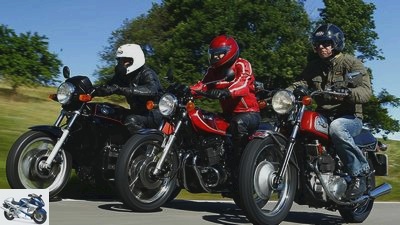
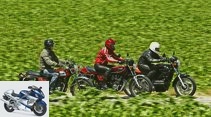
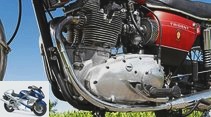
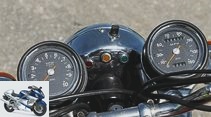
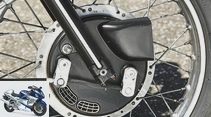
34 photos
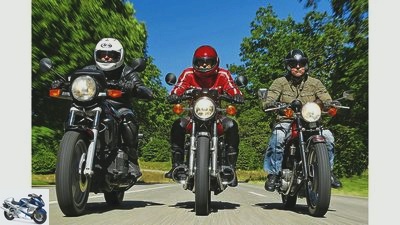
www.factstudio.de
1/34
Picture gallery, On the move: BMW K 75, Triumph Trident T150, Yamaha XS 750.
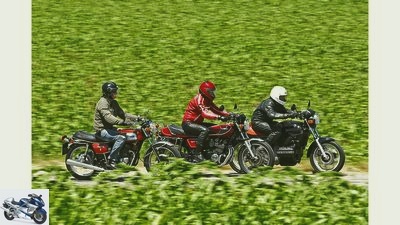
www.factstudio.de
2/34
If you are into pounding singles or twins, you can hardly warm up to rotary organ four-cylinder and vice versa. Right in the middle, however, lies the perhaps true solution, the three-cylinder that was previously widespread, then long orphaned and now rediscovered.
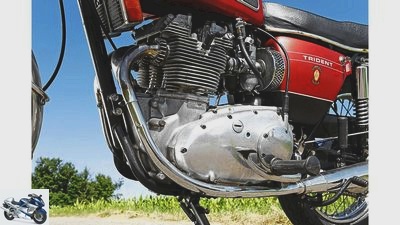
www.factstudio.de
3/34
Triumph Trident T150: The manifold of the middle cylinder splits after the outlet, the two pipes open into the respective outer manifold.
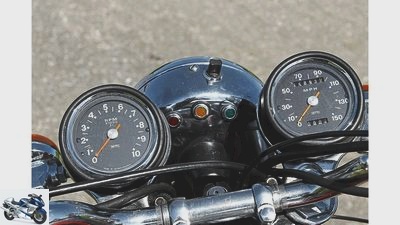
www.factstudio.de
4/34
The Smiths instruments show quite precisely, the (mile) speedometer scale seems slightly exaggerated.

www.factstudio.de
5/34
The front duplex drum brake with the huge air scoop tries to slow down.
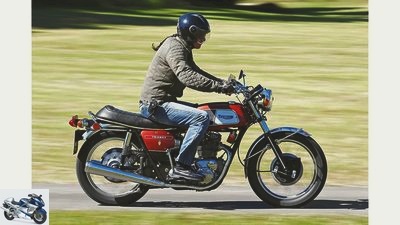
www.factstudio.de
6/34
Motorcycles with a robust character for tough and smart types were the Triumph / BSA three-cylinder even back then.
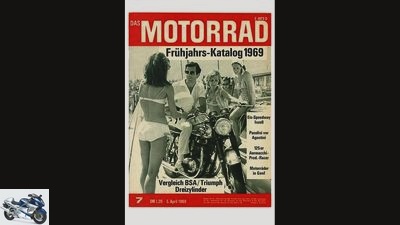
7/34
… As the cover picture of the 1969 MOTORRAD issue clearly shows.
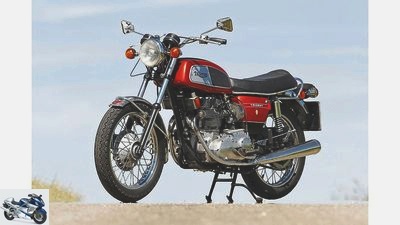
www.factstudio.de
8/34
Triumph Trident t150.
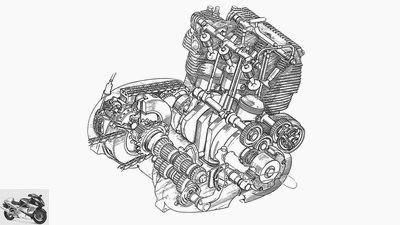
9/34
The rather complex, slightly long-stroke bumper motor was also installed in the BSA Rocket 3 (slightly inclined forward).
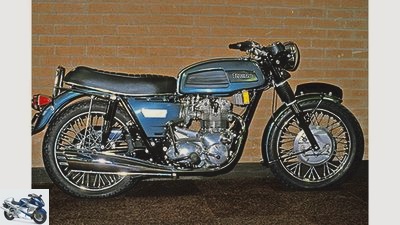
10/34
History: 1968/69: Parallel to the BSA Rocket 3, the Trident T150 first came onto the US market: angularly styled, with “ray-gun” silencers, drum brakes at the front and four-speed right-hand shift.
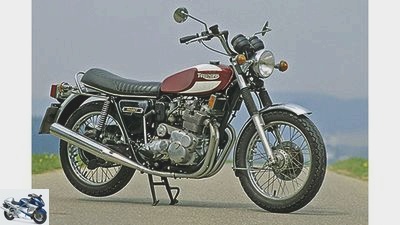
11/34
History: 1975/76: The T160 was visually and technically improved with a new exhaust, front / rear disc brakes, left-hand five-speed gearbox as well as an electric and kick starter.
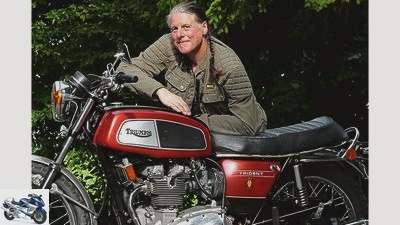
Baier
12/34
Reinhold Baier, owner of the Triumph Trident, fulfilled his wish for the three-cylinder a few years ago. "It’s a lot of fun to own an icon of English motorcycle art with this trident."
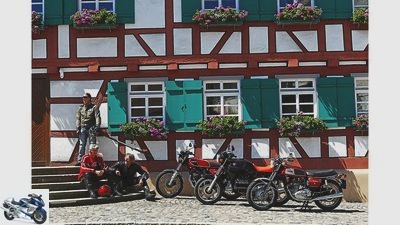
www.factstudio.de
13/34
Picture gallery, On the move: BMW K 75, Triumph Trident T150, Yamaha XS 750.
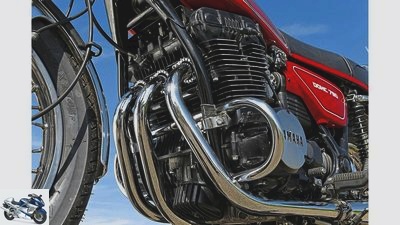
www.factstudio.de
14/34
Yamaha XS 750: The 747 does not represent a jumbo jet here, but rather the displacement of the slim three-cylinder.
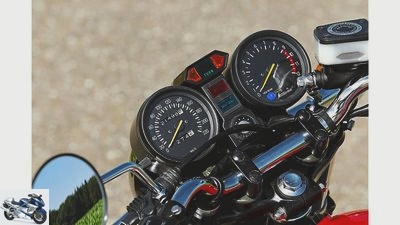
www.factstudio.de
15/34
There are clear messages in the 70s style in the straightforward cockpit, which according to a test from 1979 shows extremely precisely.
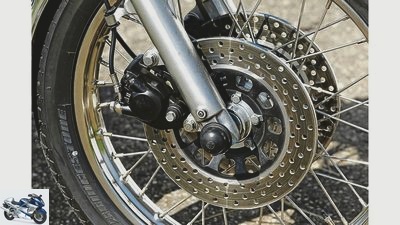
www.factstudio.de
16/34
Simple but effective: the 265 mm double disc brake with fixed calipers. Punch was made afterwards.
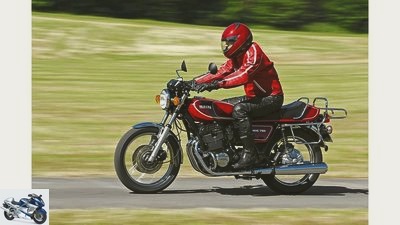
www.factstudio.de
17/34
“The ideal travel machine?” Asked MOTORRAD in 1977.
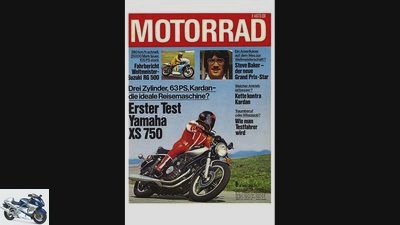
18/34
… Yes, and an ideal companion for speedy, stylish gliding – for bikers who ride with both eyes and ears.
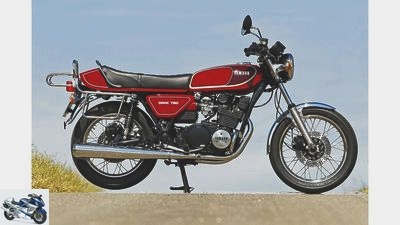
www.factstudio.de
19/34
Yamaha XS 750.
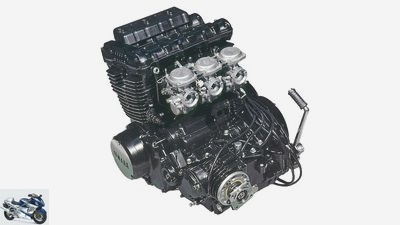
20/34
The slim triplet with an almost square bore / stroke ratio is now considered a reliable endurance runner
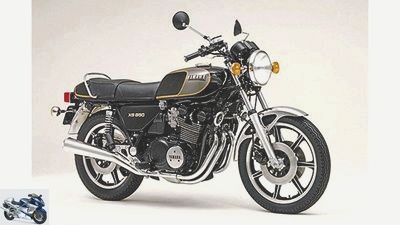
21/34
History: 1980: With a larger bore and 826 cm³ displacement, the XS 850 followed in 1980 with 79 hp and a larger oil pan, additional oil cooler and a somewhat firmer chassis. Price: 7915 marks.
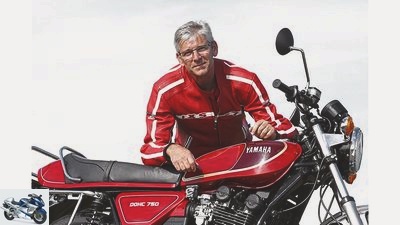
www.factstudio.de
22/34
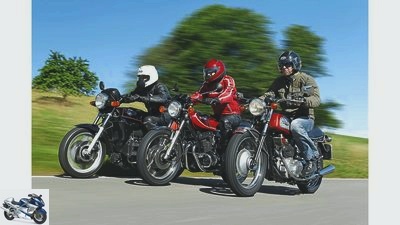
www.factstudio.de
23/34
Picture gallery, On the move: BMW K 75, Triumph Trident T150, Yamaha XS 750.

www.factstudio.de
24/34
BMW K 75: The longitudinally installed, horizontal BMW three-cylinder offers state-of-the-art technology such as fuel injection with fuel cut-off, the exhaust is made entirely of stainless steel.
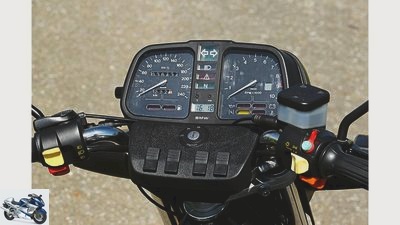
www.factstudio.de
25/34
Playful, colorful handlebar switches and a clunky but informative cockpit with gear indicator.
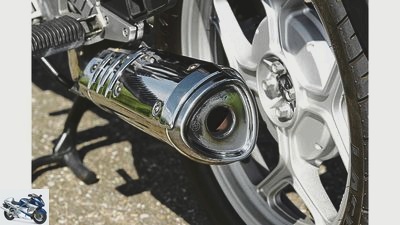
www.factstudio.de
26/34
The triangular shaped silencer pays homage to the number of cylinders.
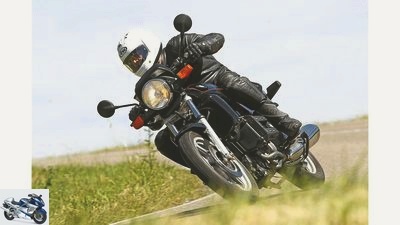
www.factstudio.de
27/34
Economical, convenient, suitable for travel …
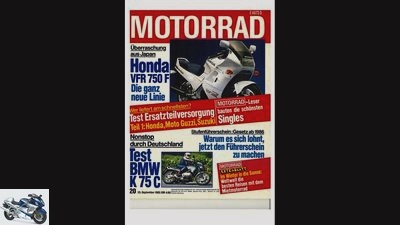
28/34
… the first test in MOTORRAD 20/1985 certifies the K 75 Tourer qualities like the K 100, of which it has 50 percent of the parts.
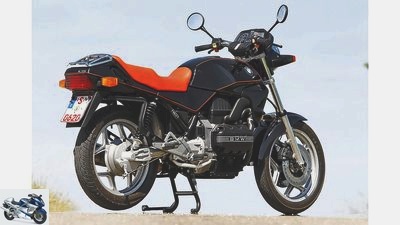
www.factstudio.de
29/34
BMW K 75.
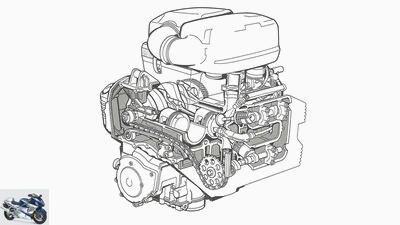
BMW
30/34
Quiet thanks to water cooling, smooth-running thanks to the balancer shaft – the extremely sophisticated BMW triplet.
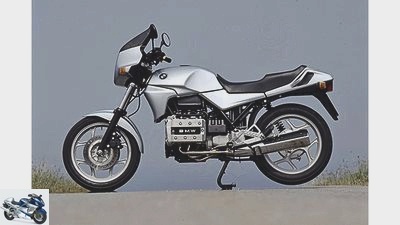
31/34
History: 1985: The K 75 C opens the model range and justifies the introduction of the Fluidbloc due to the handlebars. It was officially withdrawn from the program in 1988, but was sold until 1990. Price: (1985) 13,290 marks.
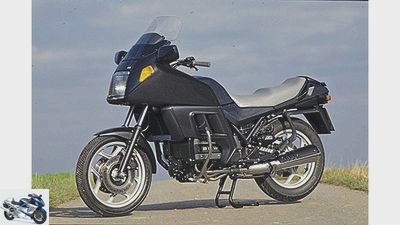
32/34
History: 1990: The tourer version K 75 RT was added as the last variant and turned out to be the best-selling model by the end of the K 75 series in 1996 with 21,264 units.
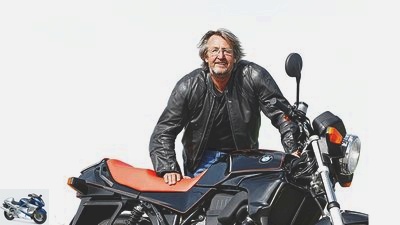
www.factstudio.de
33/34
Gabriel Winter, photo and test driver for the BMW K 75 is fascinated by the BMW with its silky smooth running, cultivated three-cylinder, the progressive technology and the high quality workmanship.
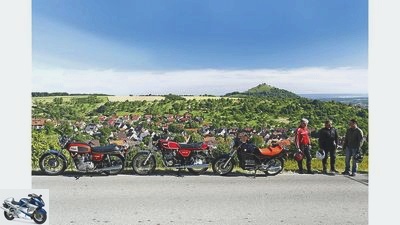
www.factstudio.de
34/34
Picture gallery, On the move: BMW K 75, Triumph Trident T150, Yamaha XS 750.
On the road with the BMW K 75, Triumph Trident T150 and Yamaha XS 750
All good things come in threes
Content of
If twins pound too much and four-cylinder whisper too much, you often develop into a fan of the triplet. We drummed up three three-cylinder cylinders from three decades and went on a mighty sound tour.
Not just the eye, but also the ear. Discussions about the only true sound of the preferred engine type have sparked as often as the question of the only true engine concept – two or four-stroke engines. If you are into pounding singles or twins, you can hardly warm up to rotary organ four-cylinder and vice versa. But right in the middle is perhaps the real solution, the three-cylinder that was previously widespread, then long orphaned and now rediscovered. And who has ever looked expectantly at a Porsche in the face of an approaching vehicle with a high-revving engine and beguiling sound and then amazes one Ysaw amaha XS 750 turn the corner, knows what we’re talking about. However, the sound hardly played a role in the manufacturer’s decision; it was rather practical reasons such as the overall width, design effort and costs that tipped the scales in favor of a specific engine configuration.
Buy complete article
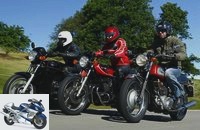
On the road with the BMW K 75, Triumph Trident T150 and Yamaha XS 750
All good things come in threes
Triumph Trident T150 – no mechanical quiet step
At Triumph, the successful British manufacturer of powerful and characterful twins, the further increase in displacement and power of the two-cylinder was seen as exhausted and fell victim to the idea of the three-cylinder in the early 1960s. However, it should still be a few years before series production. The designers Bert Hopwood and Doug Hele had the first sketches of an inline three-cylinder in their drawer at the end of 1962, but Triumph boss Edward Turner waved them off, even when the two presented more specific plans in 1963. Only Turner’s successor Harry Sturgeon was finally convinced in 1964.
The first draft was based on the values of the Speed Twin with a smaller bore and more stroke (63 x 80 mm), which made the Triple build extremely narrow. Ultimately, Hele and Hopwood changed the geometry of the engine to 67 x 70 mm, which led to the 740.4 cc displacement of the Trident engine. The first prototype was completed after a year and delivered an impressive 58 hp at 7250 rpm on the test bench. Good thing, because the rumors that Honda were working on a 750cc four-cylinder were growing. The smooth running of the triplet with the forged, four-bearing crankshaft and 120 degrees crank pin offset should be able to compete with that of a four-cylinder. Theoretically, this should be feasible, after all, first and second order inertial forces can be switched off with this configuration. The primary drive in the series was taken over by a triple roller chain instead of the noisy straight-toothed gears.
So everything is quiet and low in vibration? Theoretically. In practice, the Triumph-Drilling is not a mechanical quiet step, even a turbine-like run is alien to it. Last but not least, the fans love him as a representative of honest mechanical engineering with authentic and noticeable expressions of life. Fans like Reinhold Baier, the owner of our Foto-Triumph, who has owned many motorcycles in his biker life. Japanese four-cylinder like the FJ 1200 or three-cylinder like the XS 750/850. Two years ago he deliberately added the British “original” to his fleet (including various Harleys, a Norton and a Ducati). “I have ridden long enough powerful motorcycles, including Japanese ones that are only fun to drive. I like the robust character, the strong start. That’s what I love about the Triumph. “
Triumph Trident T150 with right shift
Will she love me too and jump on without any problems? Ignition on, cold start measures are omitted – the triplet is still warm – one courageous kick, the Trident reports on the first attempt for duty. It sounds robust from the mufflers, the non-optimal idling behavior has to be given a helping hand with occasional bursts of throttle. Reinhold’s bike is still from the first series, i.e. a T150, built in 1971, still with right-hand shift and four-speed gearbox.
The five-speed gearbox was only available from mid-1972 with the introduction of the T150V, at the end of 1972 the drum brake was replaced by a single disc. It sits enthroned on the Trident in a typically British style, upright, legs apart, feet on the pegs mounted far forward, hands on the broad, slightly curved handlebars. Somebody called this a man’s driver’s attitude. The single-disc dry clutch does not require as much manual force as feared, but the slides of the Amal carburettors need to be moved by turning the throttle firmly. The British woman starts moving with a hearty roar, the right foot quickly gets used to its task, the transmission plays well and smoothly when changing gears. In a jiffy, the last corridor is in, and you can linger in it for a long time as long as there are no tight turns. The slightly long-stroke engine cleanly picks up the gas even at low speed and pushes the load forward powerfully. He does not need high speeds.
And these are not in fashion today either, even if its high revving up to the rated speed of 7250 rpm was praised in the 1969 test. But the engine recently overhauled by Reinhold is still quite virgin and deserves a little rest. We don’t want to win any races, with the cautious drum brakes at the front this would be difficult. The left foot is often allowed to fulfill its new task, and I am glad that the rear drum is so effective. Drive around, enjoy, roll quickly into the curve, take a train out again – this gives the Trident driver real pleasure, especially since the chassis can do a lot and the tires or footrests set the limits.
In contrast to the almost identical group sister BSA Rocket 3 (the Triple designed by Triumph was also built at BSA in Birmingham), which has a double loop frame, the three here hangs in a single-tube frame with a screwed-on rear frame and split beams. It does its job very well and does not show any weakness in terms of driving stability. With all the loud and pithy expressions of life of the triple with increasing speed, the vibrations are surprisingly limited. Sure, it tingles a little in the hands, in the feet and the sparsely upholstered bench allows some penetration to the buttocks, but this only bothers after a long journey. And, according to old English insults, it should be over before dark because of the vulnerable Lucas electrics. Reinhold has already found a remedy here, however: a reinforced generator and a Sparx regulator, together with the Australian Trispark ignition, ensure more reliability.
Yamaha XS 750 – in the Porsche test department
That’s what the Japanese generally say, and the Yamaha XS 750 is no exception, apart from a few small weak points. But the Yamaha also has a history that has to do with the American market. With increasing experience with touring four-stroke models, which were increasingly displacing the sporty two-stroke models, outside of Japan, mainly in the USA and Europe, the desire for a touring motorcycle with cardan drive arose. As early as 1975, Yamaha presented the GX 750 (with spoked wheels and three-in-one system) at the trade fair in Milan, but from 1976 it was only offered in the USA. It was not until 1977 that the Yamaha XS 750 could be bought in Germany for 7250 marks. From the beginning, however, German technicians had a hand in the game: The complex drive train was developed together with the transmission manufacturer Getrag, and extensive testing took place in Porsche’s testing department. Instead of a universal joint, a homokinetic joint was used between the angle drive and the cardan shaft.
The cardan did not cause any problems, but initial problems with engine damage and enormous oil consumption forced Yamaha to accept goodwill and to convert various parts free of charge, most of which were also incorporated into the series for 1978. Among other things, a larger oil pan (with modified baffles), a more powerful oil pump, a reinforced primary chain and modified piston rings were used. In addition, buyers of a 1978 model now enjoyed a transistor ignition, H4 light and the three-way adjustable fork. The owners of the early models occasionally struggled with the initial 64 hp, which is why Yamaha decided to give the 1978 model a boost to 74 hp, achieved through double-ball combustion chambers, sharper camshafts, higher compression and modified mufflers. Now the customers were calm and satisfied.
Feels like a high sitting position on the XS 750
Ekkehard Lemke can confirm this – he already owned an XS at the age of 21, with which he completed numerous tours with passenger and luggage. And after a few years of abstinence, he has had one again since 1998 – a well-maintained 1979 specimen that we now use as a photo model. The Pforzheimer swears by the fat Yamaha tourers, he recently sold a second, practically new Yamaha XS 750, but he will hardly ever part with the current XS 750 and his XS 1100. “I now want to be able to look after my vehicles, drive and enjoy them,” he explains the downsizing of the vehicle fleet.
Like all Yamaha XS 750 from 1979 onwards, his also dispenses with the kick starter, but has the enclosed jump start cable for emergencies. He deliberately replaced the 24-liter tank built in from 1979. “The old 17-liter tank is simply slimmer and I like it better,” he explains his measure. I see it the same way and cannot hide my secret affection for the XS. Will today’s driving experience make me brood and buy again? Ekkehard gives me the keys in a relaxed manner. With the Yamaha, I don’t have to worry about the two-stage flap choke, which has been easier to dose since 1978 – the XS treble is still crackling. Immediately after getting on, the perceived high seating position, high above the tank and close to the not too wide, inexpensive cranked handlebars surprises you. At the Triumph I had to, here I can no longer pedal – the pressure on the button immediately gets the treble going, a subtle, bassy hum is heard – let’s go. The clutch and gear shift do their job smoothly, and this XS certainly does not have the typical problem with the second gear jumping out.
Of course, you don’t need high speeds to roll around quickly, the 750 pulls up wonderfully evenly from the very bottom, hardly vibrates, at least never annoyingly, and gives a little additional kick from around 5500 rpm. But it’s not the performance that lets you turn a little higher than necessary every now and then, it’s this inimitable triple sound that tempts you to do so. Probably no other three-cylinder sounds so wonderfully like the Porsche six-cylinder as the XS engine. As I said: the ear goes with you. The first meandering curve is approaching – thanks to the double pane at the front, there is no stress here. It has always been considered to be gripping and easy to dose, Ekkehard has given his XS perforated washers and steel braided lines, this works as a contemporary conversion and is therefore permitted. But it is also possible to take a lot of momentum into the curve, especially since our Foto-XS has almost new tires and is very neutral, even relatively easy to handle given its impressive weight of almost 260 kilograms. The well-known cardan games, i.e. hardening and rearing up when accelerating and the dreaded slump when releasing the accelerator, the Yamaha can only partially do. Cardan reactions can be felt, but not particularly annoying. The difference to the chain would only become apparent in sporty use and a rough hand on the throttle, but who would want to abuse an XS as a sport bike? Its character is matched by rapid but stylish gliding, just as you would move a four-wheeled Gran Tourismo, such as a Porsche 928 or a BMW 850.
BMW K 75 – the flying brick
Which brings us back to Germany and the third triplet in this round: the BMW K 75. Welcome to the 1980s. As with the Triumph, the odd number of cylinders in the BMW also has its origin in an even number: in the case of the British one, a cylinder was quasi docked onto the 500 twin, in the case of the K 75 a cylinder “sawn off”. Namely from the already known four-cylinder of the K 100. The concept of the horizontal in-line engine offered manifold possibilities by omitting or increasing it, even a 1250 five-cylinder would have been conceivable. In this way, however, the cast aluminum cylinder block was shortened and the crankshaft was provided with a crank pin offset of 120 degrees in order to eliminate the free inertia forces in a familiar manner. The still existing moments of mass were kept in check with the help of weights on the output shaft, on which the single-disc dry clutch is also located at the front.
So that the triplet did not lose a quarter of the output of the K 100 engine, the BMW developers took measures to achieve the target of 100 hp per liter. So changed combustion chambers, a higher compression ratio and a modified exhaust system were used – voilà, the 75 hp were achieved. Otherwise, the K 75 engine followed the modular principle, stroke and bore are identical to the four-cylinder, the valve train also via two overhead camshafts and bucket tappets, the Bosch LE-Jetronic is derived from the K 100 and adapted. As with its big sister, the engine is suspended in the steel tube bridge frame, a little further back in the frame because of the shorter overall length.
The BMW moves silky smooth and quietly
The first variant, called the K 75 C, which appeared in September 1985 with a handlebar-mounted fairing, immediately received criticism because of suspension problems and the tendency to knock the handlebars. BMW reacted swiftly and developed the so-called Fluidbloc, a friction damper made of special rubber inserted into the steering head tube, which was installed as standard from 1986 and ensured quiet. The K 75 S, which had long been designed in parallel, with shortened spring travel, sporty half-shell and rear disc brake made a great impression, but at a significantly higher price. So BMW acted consistently by adding a nude variant that was attractive in terms of color and price – the black K 75 with an orange seat was available for “only” 11,990 marks. Jochen Siebenrock, BMW dealer and two-valve boxer specialist (www.siebenrock.com) made one available to us from his private collection.
The injection engine has always been considered a reliable starter, and it also makes today’s cold start easy for the driver: adjust the choke lever with the left thumb, and the triplet hums at the push of a button. Accompanied by the clear and typical howling – the gears of the primary drive run with energy-saving straight teeth instead of the smooth-running helical teeth as on the K 100. The seating position fits, I feel comfortable in the wide, almost too spongy padded saddle behind the towering, long tank, too when he stretches his arms properly to the handlebars. The BMW K 75 starts moving silently and smoothly, the smoothness of the engine fascinates from the first meter. Vibrations? Can not really be felt anywhere. Even at higher speeds, there is no tingling annoyance. Whereby high revs and the sporty kick (from 7000 rpm, the revving pleasure decreases again) are not so much the thing of the BMW triplet. More like the full draft. From as little as 1500 rpm you can pull up the gas in every gear and reap willing propulsion. From 4000, at the latest 5000 tours, the real, true three-cylinder sound sets in. Yes, it also sounds a bit like Porsche, albeit still subtle and a bit pressed, muffled.
The transmission, tough but honest, only wants to be operated with vigor when downshifting, preferably with double-declutching. The gradation fits, the unspectacularly designed brake decelerates surprisingly effectively and easily. Everything is there for cheerful cornering, if it weren’t for this constantly staggering steering feeling. It’s often been described as akin to suspecting a defective steering head bearing, and, yes, that’s exactly how it feels. Even when driving slowly straight ahead, the K 75 always wants to be kept focused on course. In addition, the BMW, which weighs just under 230 kilos, always seems more cumbersome when turning and more top-heavy than the 30 kilos heavier Yamaha. Okay, it may be partly due to the tires that are no longer completely fresh, but this is where the Fluidbloc shows its often criticized side. However, it can actually walk straight ahead on the motorway at a higher speed. One is almost sorry for the supple engine, it deserves a more neutral, more manageable chassis. At some point, BMW also recognized that the smooth-running, powerful threesome also has tourist qualities. From 1990 the Bavarians combined the engine and its low-maintenance cardan drive with the full fairing of the K 100 RT suitable for touring. And in retrospect, the K 75 RT turned out to be the best-selling K 75. Perhaps a little bit according to the slightly modified rule: the ear travels with you.
In detail: Triumph Trident T150 (1968–1972)
Price 1973: 6310 marks
technology
The three-cylinder construction is based in principle on Triumph’s time-honored Twins. In order to be able to continue to use proven components, the housing was complex, with many covers, sealing surfaces, threaded rods and dowel pins. The 120-degree crankshaft has four bearings: two slide bearings in the middle, one ball bearing on the left, one roller bearing on the right stump. For the valve train, gears on the right drive the intake camshaft behind and the exhaust camshaft in front of the cylinder base. From there, short rockers and bumpers lead to the upper floor. Here, a rocker arm shaft rotates on the inlet and outlet side in order to control two valves per cylinder using a rocker arm. The primary drive is taken over by a triplex chain in a separate housing on the left-hand side, on the T160 from 1975 a duplex chain. The rotor of the alternator, still attached to the left crankshaft stub in the Twins, was moved to the right, in front of the gears of the camshaft drive. This should save overall width, even if the shape of the Triumph-typical, heart-shaped timing case cover suffered. A five-speed gearbox was available in the T150V model from mid-1972. Screwing on the triple is something for experts: In order to get to the crankshaft, the engine including the gearbox must be dismantled into all individual parts. Those who value originality and refrain from retrofitting have to live with the difficult-to-adjust Amal Concentric 626 carburettors.
Used check
It is not uncommon for the engine to leak from housing seals and tappet tubes. Because the rocker arms exert pressure on one side of the valve stems, their guides quickly deflect. Increased oil consumption (blue clouds when taking off the gas!) Are the result. This can be remedied by valve guides made of modern, harder material and a valve stem seal on the inlet side. Very important: The Triple regularly requires fresh lubricant so that no oil deposits can form. It is highly recommended to replace the vulnerable original ignition system with breaker contacts from Lucas with an electronic ignition from Tri-Spark (www.trispark.com.au). Furthermore, the outdated electronics for the rectifier and charge control of the battery should be replaced with more modern charge regulators. Then the ignition and electrical systems are absolutely modern.
market
Taken together, only 27,500 BSA Rocket 3 and Triumph Trident were produced. And around three quarters of them went to the USA. That makes the range of British tridents manageable in this country. In view of the rather complex technology, however, the demand was also limited. This seems to be changing now – interest in this fancy model is growing. The entry level starts at around 3500 euros for a handicraft object, good originals or properly restored machines cost a good 6000 to 7000, top copies up to 10,000 euros.
Parts / specialists
www.agos-motorcycles.de, 63691 Ranstadt, phone: 060 41/96 28 36
Clubs and forums
http://www.cbbc.de
Data (type Trident T150)
Engine: Air-cooled three-cylinder four-stroke in-line engine, two underlying camshafts (ohv), two valves per cylinder, operated via bumpers and rocker arms, displacement 740 cm³, bore x stroke 67 x 70 mm, compression 9.5: 1, power 43 kW ( 58 hp) at 7250 rpm
Power transmission: single-disc dry clutch, five-speed gearbox, chain drive
Chassis: single-loop frame made of tubular steel, telescopic fork at the front, tubular steel stereo swing arm with two spring struts, wire-spoke wheels with steel rims, tires 3.25 H 19 at the front, 4.10 H 19 at the rear, duplex / simplex drum brake front / rear, Ø 200/180 mm
Dimensions and weights: tank capacity 19 liters, weight with a full tank 220 kg
Performance: Top speed 193 km / h
In detail: Yamaha XS 750 (1977–1981)
Price 1979: 7,318 marks
technology
With the air-cooled, slide bearing dohc three-cylinder and the cardan drive train with double deflection co-developed by the German transmission specialist Getrag, Yamaha broke new ground in 1976. Only presented in Europe in 1977, the triplet caused problems at first: High oil consumption and the small oil pan could quickly lead to bearing damage due to a lack of oil. In addition, the undersized primary chain elongates too quickly. As early as 1978, the XS was fitted with a larger oil pan, a more powerful oil pump, modified piston rings and a reinforced primary chain. On the occasion, the 750 was also given a power boost from 64 to 74 hp, achieved through double-ball combustion chambers, sharper camshafts, higher compression (9.2 instead of 8.5: 1) and new mufflers. A Hitachi transistor ignition replaced the contact ignition and a two-stage choke improved the warm-up phase. From then on there was calm and largely satisfaction among the owners. The rough, but hearty treble is convincing with its powerful pulling force and reliability and durability. The changes for 1979 were therefore limited: Touring riders were happy about the tank that was enlarged from 17 to 24 liters and the now more stable main stand, but had to do without the kick starter. Yamaha optimized the engine with an even more precisely manufactured crankshaft and reduced bearing play. The frequently complained problems with jumping out of the second gear result from wear on the claws of the second gear wheel and the corresponding pockets for the claws of the fifth gear wheel. The claws are rounded at the edges and the edges of the pockets as well, in the case of models from 1979 onwards, these problems are supposed to be solved by constructive measures (safety device, washer).
Used check
Anyone interested in an XS 750 from 1977 should ensure that the large oil pan has been installed and that the XS benefited from the retrofit campaign. In any case, checking the primary chain is quite simple: unscrew the engine oil filler plug, insert your finger through the opening and try to pull the primary chain upwards. If this can be pulled up to the housing, at the end it needs to be replaced. Models from 1978 onwards do not pose too great a risk, and mileage of over 100,000 kilometers is not uncommon. The series suspension struts were often already or should be replaced by cones, the rust-prone exhaust system should be examined carefully – the right pot is welded to the middle manifold and is significantly more expensive than the solo pot on the left. It is difficult to get a replacement, the Yamaha three-cylinder IG can help with the procurement of replica systems. Before you buy it is essential to take a test drive and ensure that the second gear that often pops out clicks into place (see above)..
market
Usable XS 750 can be found from around 1500 euros, even with a manageable mileage. Only very well-kept specimens with less than 30,000 kilometers sometimes cost 3,000 to 4,000 euros. Collectibles in new condition for or over 6000 euros. The XS 850 from 1980 is only a few hundred euros more expensive.
Parts / specialists
Horst Meise in Itzehoe, phone 0 48 21/7 42 83, www.yamahaklassikerteile.de
Peter Themm in Kudow, www.piets-youngtimer.de
Clubs and Forums
www.triples.de
www.yamahatriples.com
www.yamahatriples.com
Data (type 3G9)
Engine: Air-cooled three-cylinder four-stroke in-line engine, two overhead camshafts, two valves per cylinder, actuated via bucket tappets, displacement 747 cm³, output 54 kW (74 hp) at 8400 rpm
Power transmission: multi-disc oil bath clutch, five-speed gearbox, cardan drive
Chassis: Double loop frame made of tubular steel, telescopic fork at the front, Ø 36 mm, two-arm swing arm with two spring struts, cast light alloy wheels, tires 3.25 H 19 at the front, 4.00 H 18 at the rear, double disc brake at the front / disc brake at the rear, Ø 265 mm, with fixed calipers
Dimensions and weights: wheelbase 1470 mm, weight with a full tank 257 kg
Performance: Top speed 198 km / h
In detail: BMW K 75 (1986–1996)
Price 1986: 11,990 marks
technology
The horizontal three-cylinder, derived from the four-cylinder of the K 100, shines with extraordinary smoothness. In addition to the 120 degree crank pin offset, the output shaft, which functions as a balance shaft thanks to forged counterweights, helps it. This also carries the single-disc dry clutch, and the combined oil / water pump rotates at its front end. Thanks to gasoline injection via Bosch LE-Jetronic, the recumbent dohc three-seater offers smooth throttle response from idle speed and shines with very low fuel consumption. The cardan drive works in the single-sided swing arm made of cast aluminum, which is mounted in the gearbox housing, and manages with just one deflection, in the rear-wheel gearbox – an advantage of the engine installation position, in which the crankshaft runs alongside the gearbox shafts and the cardan shaft.
Used check
The K 75 series has only a few and hardly any serious weak points. Defects and leaks in the water / oil pump unit can be observed again and again, as are generally leaks in the cooling system / cooling hoses (defective radiator caps). Not the exit, but the entry of water is a problem in the cockpit, which often leads to the failure of the speedometer. Models after 1989 have a cover with a membrane, which provides a remedy – old models can be retrofitted. Vehicles that have been standing still for years often have problems with a suspended fuel pump – so at least let the engine run for a test before buying. If you want to be on the safe side, you should look around for a model from 1991: by then at the latest, all improvements have been incorporated into the series, such as the optional ABS (from 1990), the stiffer chassis and the better Showa fork (1990 or 1991) , the 17-inch rear wheel and disc brake (1991) and a more powerful alternator (1993). If you get a blue cloud of smoke from the exhaust after parking for a long time on the side stand, you don’t need to worry. The cause is banal. Due to the negative pressure that occurs when the hot engine cools down, a little oil is sucked into the combustion chambers and burned with enormous smoke when the engine starts.
market
Usable specimens with high mileage of 50,000 to over 100,000 kilometers are available from around 1200 euros. Well-maintained K 75s with only around 30,000 kilometers sometimes cost between 3500 and 4000 euros. Special series such as the Ultima, fully equipped RT or models with ABS, i.e. generally late vehicles built between 1990 and 1996, are in demand.
Series and sales figures
K 75 basic version: 18 485 pieces
1986-1996
K 75 C: 9566 pieces
1985-1990
K 75 S: 18 649 pieces
1985-1995
K 75 RT: 21 264 pieces
1990-1996
Parts / specialists
www.motobins.co.uk
www.wuedo.de
www.siebenrock.com
Clubs and forums
www.flyingbrick.de
Data (type K569)
Engine: Water-cooled three-cylinder four-stroke in-line engine, installed lengthways, two overhead camshafts, two valves per cylinder, actuated via bucket tappets, Bosch LE-Jetronic injection, displacement 740 cm³, output 55 kW (75 PS) at 8500 rpm
Power transmission: single-disc dry clutch, five-speed gearbox, cardan drive
Chassis: tubular steel bridge frame, front telescopic fork, Ø 41.4 mm, single-sided swing arm made of aluminum, mono-suspension strut, cast light alloy wheels, tires 100/90 H 18 front, 120/90 H 18 rear, double disc brake front, Ø 285 mm, two-piston calipers , Rear drum brake, Ø 200 mm
Dimensions and weights: wheelbase 1516 mm, weight with a full tank of 228 kg
Driving performance: top speed 200 km / h
Related articles
-
Schmieder 16 pictures Schmieder 1/16 The three-cylinder requires sensitivity, you have to put yourself in it. Schmieder 2/16 The oil channel of the …
-
On the move: Triumph Bonneville and Yamaha TX 750
www. 40 pictures , archive 1/40 When comparing the British original Triumph Bonneville 750 with the Japanese answer Yamaha TX …
-
Suzuki GSR 600, Triumph Street Triple, Yamaha FZ6 Fazer S2
Artist Suzuki GSR 600, Triumph Street Triple, Yamaha FZ6 Fazer S2 Comparison test of mid-range bikes Middle-class bread and butter? That was once. All…
-
Kawasaki Z 750 B, Triumph Bonneville 750 and Yamaha XS 650
bilski-fotografie.de 31 pictures bilski-fotografie.de 1/31 On the move with the Kawasaki Z 750 B, Triumph Bonneville 750 and the Yamaha XS 650 ….
-
Triumph Trident Cafe Racer reader conversion
Thomas Grad 10 pictures Thomas Grad 1/10 Triumph Trident Cafe Racer Thomas Grad 2/10 The handlebar fittings milled from aluminum by Motogadget look great …
-
Comparison test: naked bikes BMW, Ducati, Triumph, Yamaha, Kawasaki
fact 66 pictures fact 1/66 If you want a real all-rounder, the Yamaha FZ8 is the right choice. fact 2/66 No trace of saving: Despite the …
-
Yamaha MT-09 and Triumph Street Triple tested
www. 35 pictures www. 1/35 Whether the multiple test winner, the Triumph Street Triple, the Yamaha MT-09 …
-
Yamaha MT-09 Tracer, MV Agusta Stradale 800 and Triumph Tiger 800 XRx
fact 22 pictures fact 1/22 MV Agusta Stradale 800, Triumph Tiger 800 XRx and Yamaha MT-09 Tracer in a comparison test. fact 2/22 One for all: …
-
Comparison test: Honda CB 1000 R, Yamaha FZ1, Triumph Speed Triple, Kawasaki Z 1000
Comparison test: Honda CB 1000 R, Yamaha FZ1, Triumph Speed Triple, Kawasaki Z 1000 Large naked bikes in comparison Contents of …
-
Kawasaki, KTM, Triumph and Yamaha
Jahn 20 pictures Triumph 1/20 Triumph 2/20 From the development phase: a model with a low-lying silencer. Triumph 3/20 Triumph 4/20 The …